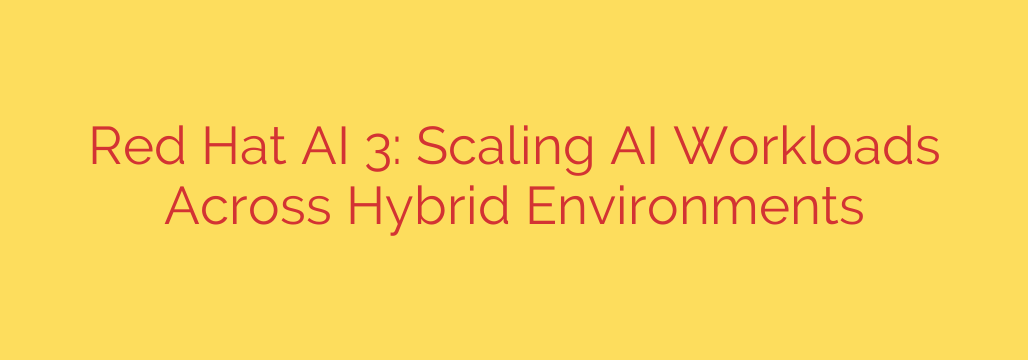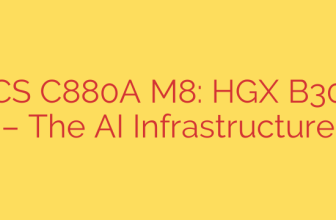
Unlocking Enterprise AI: A Guide to Scaling Workloads in a Hybrid Cloud World
Artificial intelligence has moved beyond the experimental phase and is now a critical driver of business innovation. However, many organizations face a significant hurdle when moving AI models from a developer’s laptop to full-scale production. This challenge is magnified in a hybrid environment, where data and computing resources are spread across on-premise data centers, public clouds, and edge locations.
Successfully operationalizing AI requires more than just a powerful algorithm; it demands a robust, scalable, and consistent platform. The key is to bridge the gap between data science and IT operations, creating a streamlined path to deploy, manage, and scale AI-powered applications anywhere your business operates.
The Core Challenge: AI Complexity in a Hybrid Environment
The promise of the hybrid cloud is flexibility and control, but for AI workloads, it can introduce significant complexity. Teams often grapple with inconsistent toolsets, security vulnerabilities, and fragmented workflows across different infrastructures.
Without a unified approach, organizations risk creating isolated AI silos that are difficult to manage, secure, and scale. This leads to slower innovation, higher operational costs, and an inability to adapt to changing business needs. The goal is to establish a single, consistent MLOps (Machine Learning Operations) foundation that empowers teams to build and deploy with confidence, regardless of the underlying infrastructure.
Building a Scalable Foundation for Enterprise AI
To overcome these challenges, a modern AI platform must provide a standardized environment for the entire machine learning lifecycle—from data preparation and model training to deployment and monitoring. This approach abstracts away the complexity of the underlying infrastructure, allowing teams to focus on delivering value.
Key capabilities of a successful hybrid AI platform include:
- A Consistent, Kubernetes-Native Core: A platform built on an enterprise-grade Kubernetes distribution provides a powerful, scalable, and portable foundation. This ensures that AI applications developed in one environment can be deployed seamlessly to any other, whether it’s on-premise, in AWS, Azure, Google Cloud, or at the edge.
- Flexibility for Data Scientists: Innovation thrives when experts have access to the tools they know and love. A leading AI platform must support a wide range of popular data science tools, frameworks, and libraries, such as Jupyter notebooks, TensorFlow, and PyTorch. This prevents vendor lock-in and allows teams to use the best tool for the job.
- Streamlined Model Deployment and Serving: Getting a trained model into a production application is often the hardest part. A robust platform simplifies this process by providing integrated tools for model serving. This allows trained models to be deployed as scalable, secure, and reliable API endpoints that developers can easily integrate into their applications.
- Integrated Monitoring and Management: Once a model is deployed, its performance must be continuously monitored for accuracy, drift, and fairness. A comprehensive platform offers centralized dashboards and tools for observing model behavior, enabling teams to maintain and retrain models proactively to ensure ongoing business value.
Actionable Security Tips for Your AI Infrastructure
As you scale your AI initiatives, security and governance become paramount. Integrating security into your MLOps workflow from the beginning is essential for protecting sensitive data and ensuring regulatory compliance.
- Implement Granular Access Controls: Use role-based access control (RBAC) to define who can access specific data sets, projects, and models. This ensures that data scientists, developers, and operations personnel only have the permissions necessary to perform their roles.
- Automate Security in the Pipeline: Integrate automated security scanning for vulnerabilities in your container images and application dependencies. This “shift-left” approach to security catches potential issues early in the development cycle, reducing risk in production.
- Establish Clear Data Governance: In a hybrid environment, data is constantly moving. Define and enforce clear policies for data lineage, usage, and privacy to ensure compliance with regulations like GDPR and CCPA and to maintain the integrity of your AI models.
The Future is a Unified AI Strategy
The era of isolated AI experiments is over. To truly harness the power of artificial intelligence, enterprises need a strategic, platform-driven approach. By adopting a unified solution that simplifies and accelerates the AI/ML lifecycle across hybrid environments, organizations can break down silos, enhance collaboration, and turn innovative ideas into real-world business impact. Investing in a consistent, scalable, and secure AI foundation is no longer an option—it is the key to a competitive advantage in the digital economy.
Source: https://www.helpnetsecurity.com/2025/10/15/red-hat-ai-3/








